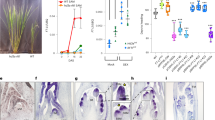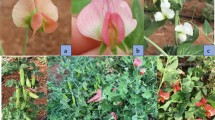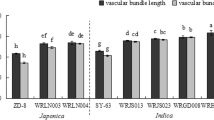Abstract
THE inflorescence of rice is a panicle; its development is different from that of the spike of cereals studied by Purvis1 and Bonnet2,3. It has been noted by Purvis1, Purvis and Gregory4, Bonnet2,3 and Sharman5 that the development of a spike is preceded by the formation of double ridges on the main rachis; one of the ridges forming into a spikelet and the other a subtending bract under an effective photoperiod and with low temperature of germination. In the absence of these conditions the primordia grow into leaves. The whole theory of the hormonal mechanism of flowering by Purvis and Gregory is based on this fundamental fact. The behaviour of rice is different from that of rye in several important aspects. The effect of short days on rice is quantitative in its flowering response6. While in winter rye Purvis and Gregory have observed that short days up to six weeks accelerate flowering and that subsequent long days are essential. Exposure to short days for periods longer than six weeks retards flowering. Tillers in rye show the same behaviour as the main shoot, indicating that the whole plant is affected by the treatment, although at the end of the treatment the majority of the vegetative buds are not yet formed. In rice (var. Rupsail) the tillers behave differently from the main shoot in respect of their leaf number and ear emergence by short-day exposure. The growing apex in its transition from vegetative growth to reproduction elongates considerably at the top, and along the edges several small groups of cells protrude which ultimately develop into branch rachides bearing more than one spikelet. Nowhere in the present investigation have double ridges, as noted in wheat, barley and rye, been seen. With an adequate dose of photoperiodic treatment the vegetative apex gradually passes into a main rachis bearing branches on which spikelets are formed. Once the rachis is formed under short-day conditions it continues to form spikelets irrespective of subsequent long days. The photoperiodic stimulus acts quantitatively on the growing apex. A minimum of four weeks exposure is necessary for 100 per cent flowering of the main shoot; after three weeks 66 per cent, and two weeks 3 per cent flower. In the case of first and second tillers six weeks are essential. Anatomical changes in the growing apices reveal that after four weeks all the vegetative apices are transformed into inflorescences; after three weeks some apices are reproductive and others remain vegetative all through.
This is a preview of subscription content, access via your institution
Access options
Subscribe to this journal
Receive 51 print issues and online access
$199.00 per year
only $3.90 per issue
Buy this article
- Purchase on SpringerLink
- Instant access to full article PDF
Prices may be subject to local taxes which are calculated during checkout
Similar content being viewed by others
References
Purvis, O. N., Ann. Bot., 48, 919 (1934).
Bonnet, O. T., J. Agric. Res., 51, 451 (1935).
Bonnet, O. T., J. Agric. Res., 53, 445 (1936).
Purvis, O. N., and Gregory, F. G., Ann. Bot., N.S. (1), 569 (1937).
Sharman, B. C., New Phyt., 46, 20.
Sircar, S. M., Proc. Nat. Inst. Sci. India, 12, 191 (1946).
Sircar, S. M., and Parija, B., Proc. Nat. Inst. Sci. India, 15, 93 (1949).
Sircar, S. M., and De, B. N., Proc. Nat. Inst. Sci. India, 14, 263 (1948).
Sircar, S. M., “Vernalization and Photoperiodism. A Symposium”. Lotsya, 1, 121 (Chronica Botanica Co., 1948).
Hamner, K. C., Cold Spring Harbor Symposia in Quant. Biol., 10, 49 (1942).
Author information
Authors and Affiliations
Rights and permissions
About this article
Cite this article
SIRCAR, S., SEN, S. Photoperiodic Induction and the Development of Growing Apex in Rice. Nature 165, 855 (1950). https://doi.org/10.1038/165855a0
Issue date:
DOI: https://doi.org/10.1038/165855a0



